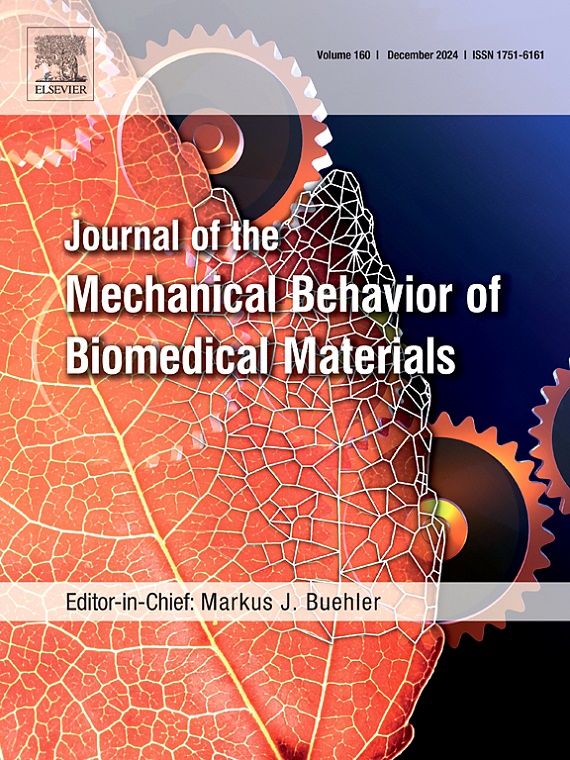The effect of presence and location of microcalcifications on atherosclerotic plaque rupture: A tissue-engineering approach
IF 3.5
2区 医学
Q2 ENGINEERING, BIOMEDICAL
Journal of the Mechanical Behavior of Biomedical Materials
Pub Date : 2025-07-16
DOI:10.1016/j.jmbbm.2025.107139
引用次数: 0
Abstract
Rupture of the cap of an atherosclerotic plaque can trigger thrombotic cardiovascular events. It has been suggested, through computational models, that the presence and specific location of microcalcifications in the atherosclerotic cap can increase the risk of cap rupture. However, the experimental confirmation of this hypothesis is lacking. In this study, we investigated how the presence and location of microcalcifications, relative to the lumen, influence (local) mechanics and rupture behavior of atherosclerotic plaque caps.
Using tissue-engineered fibrous cap analogs with hydroxyapatite (HA) clusters to mimic calcifications in human plaque caps, we replicated the microcalcification distribution observed in human carotid plaques, as identified by our histological analysis. The analogs were imaged using multiphoton microscopy with second-harmonic generation to assess local collagen fiber orientation and dispersion. Subsequently, they underwent uniaxial tensile testing to failure, during which local strain and failure characteristics were analyzed.
Our results revealed that HA clusters, particularly those in the luminal region, contribute to increased local collagen fiber dispersion. Moreover, the presence of HA clusters reduced both failure tensile stress and strain in the TE cap analogs. Besides, the rupture location shifted toward the site of HA clusters. Additionally, rupture initiation was consistently found in high-strain regions, and in 86 % of the analogs, even at the highest strain location in the sample.
Our findings suggest that microcalcification clusters in plaque caps may increase the cap rupture risk and relocate the rupture site. Moreover, local strain measurements can serve as an additional tool for plaque cap rupture risk assessment.

微钙化的存在和位置对动脉粥样硬化斑块破裂的影响:一种组织工程方法
动脉粥样硬化斑块破裂可引发血栓性心血管事件。通过计算模型表明,动脉粥样硬化帽中微钙化的存在和特定位置会增加帽破裂的风险。然而,缺乏对这一假设的实验证实。在这项研究中,我们研究了相对于管腔的微钙化的存在和位置如何影响(局部)力学和动脉粥样硬化斑块帽的破裂行为。利用组织工程纤维帽类似物与羟基磷灰石(HA)簇来模拟人类斑块帽中的钙化,我们复制了在人类颈动脉斑块中观察到的微钙化分布,正如我们的组织学分析所确定的那样。利用二次谐波产生的多光子显微镜对类似物进行成像,以评估局部胶原纤维的取向和弥散。随后进行单轴拉伸试验至失效,分析局部应变和失效特征。我们的研究结果显示,透明质酸团簇,特别是那些在管腔区域,有助于增加局部胶原纤维的分散。此外,HA簇的存在降低了TE帽类似物的失效拉应力和应变。破裂位置向HA团簇位置偏移。此外,在高应变区域和86%的类似物中,即使在样品中的最高应变位置,也始终发现破裂起始。我们的研究结果表明,斑块帽内的微钙化团簇可能增加斑块帽破裂的风险并重新定位破裂部位。此外,局部应变测量可以作为斑块帽破裂风险评估的附加工具。
本文章由计算机程序翻译,如有差异,请以英文原文为准。
求助全文
约1分钟内获得全文
求助全文
来源期刊

Journal of the Mechanical Behavior of Biomedical Materials
工程技术-材料科学:生物材料
CiteScore
7.20
自引率
7.70%
发文量
505
审稿时长
46 days
期刊介绍:
The Journal of the Mechanical Behavior of Biomedical Materials is concerned with the mechanical deformation, damage and failure under applied forces, of biological material (at the tissue, cellular and molecular levels) and of biomaterials, i.e. those materials which are designed to mimic or replace biological materials.
The primary focus of the journal is the synthesis of materials science, biology, and medical and dental science. Reports of fundamental scientific investigations are welcome, as are articles concerned with the practical application of materials in medical devices. Both experimental and theoretical work is of interest; theoretical papers will normally include comparison of predictions with experimental data, though we recognize that this may not always be appropriate. The journal also publishes technical notes concerned with emerging experimental or theoretical techniques, letters to the editor and, by invitation, review articles and papers describing existing techniques for the benefit of an interdisciplinary readership.
 求助内容:
求助内容: 应助结果提醒方式:
应助结果提醒方式:


